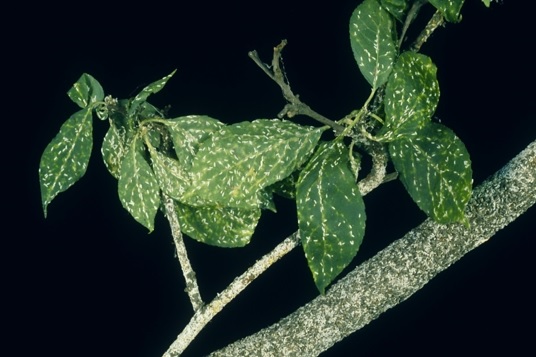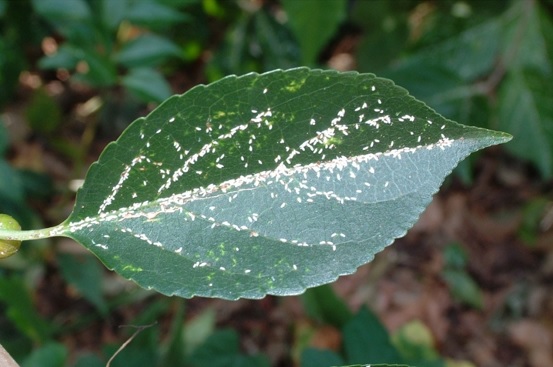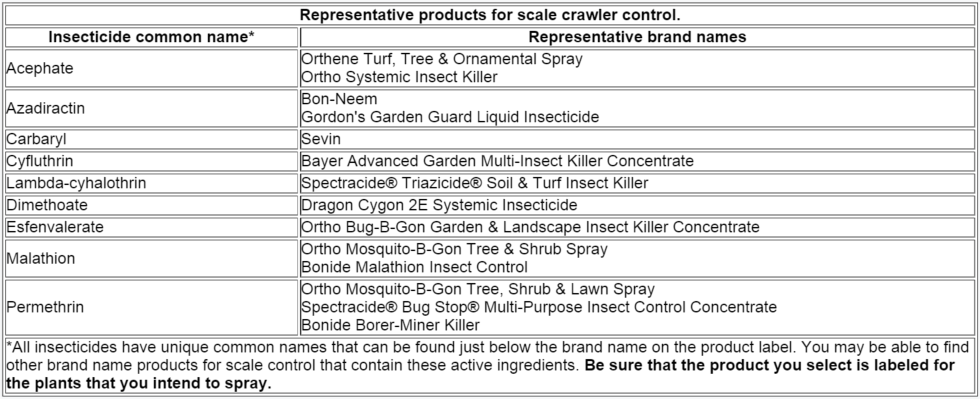Euonymous Scale
ENTFACT-428: Euonymous Scale Identification and Management | Download PDF
by Jonathan L. Larson, Extension Entomologist & Lee Townsend, Extension Specialist emeritus
University of Kentucky College of Agriculture
Euonymus Scale Fast Facts
- Euonymus scales are small, sap feeding pests found on burning bush, winter creeper, English ivy, holly, honeysuckle, lilac, and pachysandra.
- Female scales are 1/16th of an inch, oyster-shaped, and brown, while males are 1/32nd of an inch and white.
- Euonymus scale feeding will induce yellow spots on leaves and cause the plant to look water stressed and thin, if left unchecked they can kill a plant.
- Management is obtained by treating the crawler stage in May or July with a pyrethroid or oil-based insecticide or with a systemic application of dinotefuran.
Figure 1: Euonymus scales are armored scales with wax covers and they can build to threating populations on multiple species of plants (Photo by Jim Kalisch, University of Nebraska-Lincoln)
Potential Hosts
Euonymus scales are important pests of several ornamental plants, such as Euonymus species like burning bush or winter creeper, as well as English ivy, holly, honeysuckle, lilac, and pachysandra.
Symptoms and Pest Description
Scale insects are “sucking pests”, meaning they use a needle like mouth to siphon fluids from plants. Early in an infestation the plant will appear less vigorous and may even appear to be water stressed. You might also notice it losing leaves in the middle of the summer or that leaves appear to be spotted. Upon closer inspection, you will find the scale on the twigs, stems, leaves, and trunk of the plant. Female Euonymus scale are about 1/16 inch long and are brown to brown grey. Their body resembles the shape of an oyster shell. Males on the other hand, are smaller (about 1/32 inch long) and are white and oblong. When abundant, these armored scales can completely encrust twigs and leaves. When approaching a plant, the white males often stand out and help with identification.
Male euonymus scales are white and can be often be seen from a distance (Photo by Jim Kalisch, University of Nebraska-Lincoln)
Life Cycle in Kentucky
After mating in the fall, fertilized females will overwinter into the next growing season. Their eggs will hatch in a two-week window from late April to early May in central Kentucky. The immature scales that emerge are called “crawlers” as they are essentially, the only mobile life stage of a scale pest.
Crawlers will seek out a spot to feed and then will settle down on the plant and begin covering their body with a hard-waxy covering. This waxy covering is what makes a euonymus scale an armored scale.
These initial crawlers can be active until late May and reach adulthood four- to six-weeks later. These adults will mate and produce a second generation. The crawlers of that generation are active from late July into early September and adult fertilized females will overwinter into the next year.
Management
Scales tend to thrive on stressed plants. Following a recommended fertility program and watering regime will promote plant health. However, over-fertilization favors scale buildup. If practical, improve plant sites to reduce stress and promote growth. You can prune out small infestations to try and eliminate the issue or prune out sections of a large scale problem in order to make chemical control more feasible.
There are two insecticide options when considering management of euonymus scales, doing a systemic treatment or treating the crawlers directly. Whichever you choose, management may take repeated applications over a couple of growing seasons.
Treating with Systemic Insecticides
Dinotefuran (Orthro Tree & Shrub is one possible trade name) is the systemic insecticide to choose for euonymus scale management. A systemic insecticide helps to give you control without reliance on broadcast sprays on the plant. This helps keep insecticide residues contained within the plant you wish to protect and helps to ensure the product will affect the pests you are targeting. Timing is important when choosing to use a systemic product though. For euonymus scale management, dinotefuran can be applied in the fall for protection the next year or can be applied in April for management in the same growing season.
Treating Crawlers Directly
Crawlers are the most susceptible stage of an armored scale insect’s life. Once they begin to coat themselves in their waxy armor, insecticide applications have little effect on them. In order to treat the crawlers, you should be monitoring for their emergence. You can visually check in May and again in June and July. Alternatively, you can place pieces of black electrical tape (sticky side out) or double-sided tape near scale populations and monitor the tape for the crawlers and treat following the initial find.
Horticultural oils kill by suffocation or after penetrating over-wintering stages of the insect. Consequently, they may not be effective where several layers of scale coverings have accumulated. Insecticidal soaps are long chain fatty acids that kill susceptible insects through direct contact. Like horticultural oils, they require thorough coverage. Soaps leave no residue so repeated applications may be needed for some pests. These products may burn the foliage of sensitive plants, such as Japanese maple, so check the label for information about the plant species that you intend to treat.
A variety of natural and synthetic insecticides are labeled for use as sprays to control scale crawlers on landscape trees and shrubs. While the residual life of these products is generally longer than oils and soaps, timing, coverage, and precautions on damage to some plant species are very similar to those for oils and soaps.
Below are some options for scale insect crawler control.
Evaluating Control
The success or failure of control efforts may not be readily apparent but here are some things to check.
- Live scales should produce a liquid when mashed, dead scales will be dry and not "bleed" when crushed.
- New foliage should have a healthier appearance once the scale burden has been removed. Buds should break a little earlier than when the plant was infested and expanded leaves should have normal color and turgor.
Revised: 2/2021
CAUTION! Pesticide recommendations in this publication are registered for use in Kentucky, USA ONLY! The use of some products may not be legal in your state or country. Please check with your local county agent or regulatory official before using any pesticide mentioned in this publication.
Of course, ALWAYS READ AND FOLLOW LABEL DIRECTIONS FOR SAFE USE OF ANY PESTICIDE!
Images: University of Kentucky Entomology unless otherwise indicated



